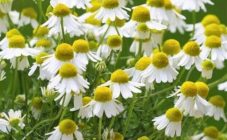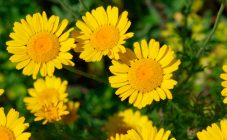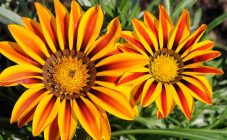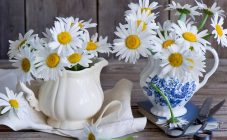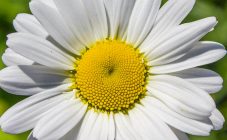Content:
Fragrant chamomile is a weedy herb that grows freely in the fields. It is in great demand not only in traditional medicine, but also in traditional medicine. This is due to a large number of useful properties. If you study the chemical composition and know how to properly use the gifts of nature, with their help it will be possible to solve many health problems. Fragrant chamomile: medicinal properties, description and application - the topic of today's article.
Chamomile without petals: characteristics and description
Chamomile without petals can have various names: Fragrant, Green, Petalless, Chamomile, called Matricaria Discoidea in Latin. Refers to annuals, herbaceous plants of the Compositae family. The plant can reach a height of 30 cm. The leaf plates have a pinnately dissected shape. Inflorescences are yellow-green in color. After flowering, seeds are formed, painted in a brown-green color. The most common name for the variety is Fragrant chamomile, since the culture exudes a pleasant aroma during flowering.
The homeland of the medicinal plant is considered to be North America and East Asia. On the territory of Russia, it became widespread in the western and southern parts of Siberia, in Chukotka, the Far East, the Arctic and some regions of the Caucasus. You can also find weeds in Belarus, Moldova and Kazakhstan.
Loves unkempt places such as wastelands, coastlines of rivers and lakes, railways and deep ditches.
A characteristic feature of the botanical species is abundant and long flowering, observed from the second or third decade of May and lasts until the end of September. Flowering has a specific, but pleasant aroma.
Chamomile: benefits and contraindications
For treatment and prevention, not only flowers are used, but also leaves. They have a pronounced anti-inflammatory and antiseptic effect. Nevertheless, inflorescences are popular in medicine. Chamomile tongueless and its useful medical properties:
- It is used for medicinal baths in the treatment of skin diseases.
- It has a pronounced antibacterial property, helps in the treatment of ARVI and ARI.
- It is used as an anthelmintic agent.
- It can be used as a laxative if necessary.
- It has a choleretic effect.
- It is used in the form of compresses and applications for rheumatism.
- It is recommended to use it regularly for pathologies of the bladder and kidneys.
- Indicated for use in flatulence.
- It is actively used in cosmetology, suitable for oily skin.
- Strengthens hair follicles, stimulates their growth.
- It has a pronounced sedative effect, is used to treat diseases of the nervous system.
- Has an analgesic effect during menstruation.
- Relieves inflammation in cystitis.
- Heals headaches.
- It is actively used to treat diseases of the reproductive system.
- It has a positive effect on the psycho-emotional state of a person.
An overdose of chamomile leads to severe headaches, which are accompanied by nausea, muscle weakness, diarrhea, and tension.
There is also a list of diseases during the course of which the use of Fragrant chamomile is undesirable:
- Anacid gastritis caused by a deficiency in the human body of hydrochloric acid.
- Disorders in the nervous system.
- Painful and copious menstrual flow.
- Propensity to diarrhea, diarrhea.
- Strictly contraindicated during pregnancy.
- Do not combine preparations with fragrant chamomile extract and homeopathic remedies.
Comparison with pharmaceutical chamomile
It is quite simple to distinguish these two plants: Fragrant chamomile lacks white petals, unlike the pharmacy one. But it is almost impossible to distinguish them by smell: during flowering, both species exude a pleasant specific smell.
The chemical composition and useful properties are similar to each other. The chemical composition of these oils includes:
- Coumarins;
- Flavonoids;
- Terpenoids.
The composition also contains a high concentration of tannins, carotene and salicylic acid.
How to properly procure
For medicinal purposes, separate flower baskets with the remains of peduncles are often used. The collection should be carried out manually, you can start it soon after the beginning of flowering - in the first trimester of June. For the entire growing season, you can carry out 4-5 harvests.
You must first remove the leaves and stems. Then they are laid out to dry in one layer. You need to dry the workpiece at a temperature not higher than 45 degrees. You can also dry the crop in attics and well-ventilated rooms.
Properly prepared raw materials have a bitter-spicy aroma. You can store dried chamomile in a room where the air humidity does not exceed 14%. Storage duration is no more than one year. Store in paper bags or cloth bags.
Chamomile Fragrant, despite being a weed, can have extremely beneficial health effects when handled skillfully. The culture is unpretentious, so it can be grown at home or in personal plots, in the latter case, you need to carefully monitor its reproduction.



